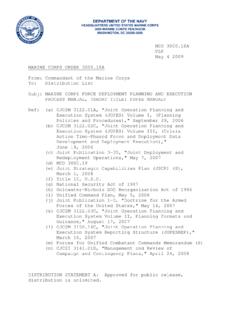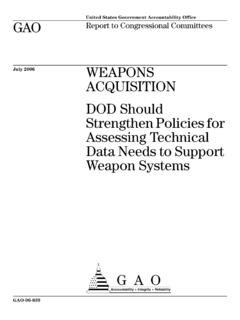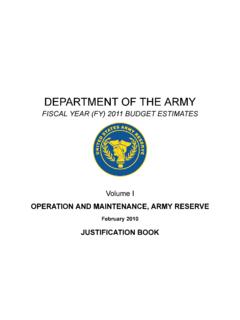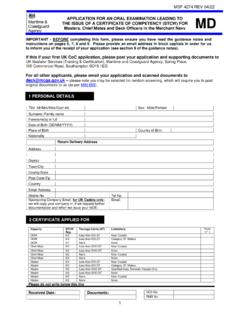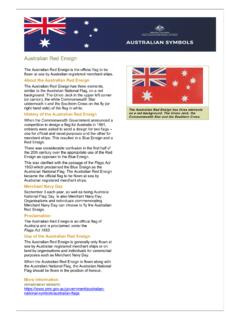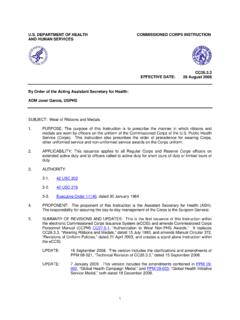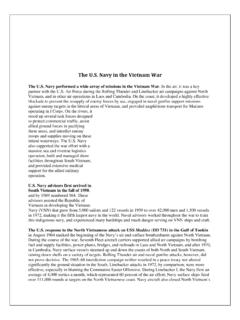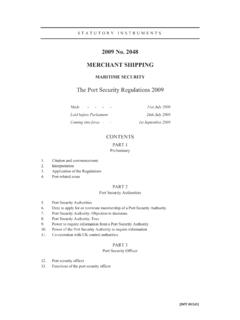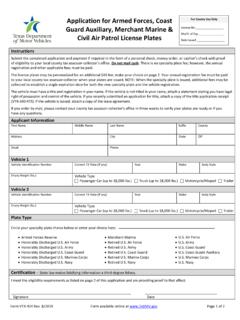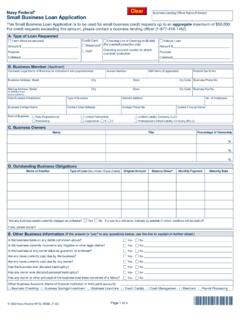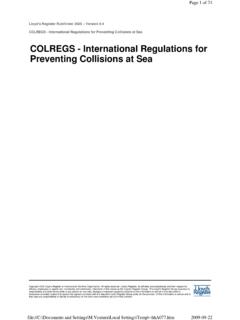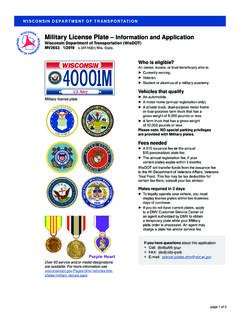Transcription of AIRCRAFT AND SHIP IDENTIFICATION - GlobalSecurity.org
1 CHAPTER 13 AIRCRAFT AND ship IDENTIFICATIONAs you learned in previous chapters, lookoutduties are some of your most important duties. As apart of your lookout duties you must be able to identifyaircraft, ships and, on occasion, submarines. Thischapter covers the basics in IDENTIFICATION IDENTIFICATIONLEARNING OBJECTIVE: Explain theprocedures for the IDENTIFICATION of AIRCRAFT ,including AIRCRAFT type, AIRCRAFT measurement,and other IDENTIFICATION IDENTIFICATION is a very important asset tothe Signalman on watch, so you must learn as muchas you can to assist in the IDENTIFICATION of this chapter will familiarize you with themost frequently used AIRCRAFT , you should guardagainst making positive IDENTIFICATION hastily. Theidentity of every AIRCRAFT must be checked by even themost knowledgeable interpreter.
2 You should studyunidentified AIRCRAFT carefully, using all availablereferences on recognition and IDENTIFICATION . Thedimensions and characteristics of all known aircraftare available from many sources, including AIRCRAFT ofthe World, AIRCRAFT Armament Handbook(Characteristics and Performance) EurasianCommunist Countries, and probably the most popular,Jane's All the World's AIRCRAFT , just to name a TYPESWhen the scale or quality of imagery makes itdifficult to identify the type of AIRCRAFT (jet or prop),you must rely on distinguishing characteristics to aidin IDENTIFICATION . A single-engine jet, as opposed to asingle-engine propeller-driven AIRCRAFT (fig. 13-1), hasone or more of the following recognitioncharacteristics:The wings are farther back from the widest part of the fuselage is near the wings are usually angled back, inboard 13-1.
3 Single-engine AIRCRAFT wings usually have less surface distance from the wings to the horizontalstabilizer is less than that from the wings to are fewer visible differences betweenmultiengine jet AIRCRAFT and multiengine propelleraircraft than between the single-engine , the twin and multiengine jets (fig. 13-2)usually have one or more of the wings are usually angled back, inboard engines are usually suspended from wings have less surface MEASUREMENTSThe two major characteristics in aircraftinterpretation are the size of the image and the shapeof various components. Accurate measurements arevital because the general appearance of certain aircraftoften may be so similar that only the difference inFigure 13-2. Twin and multiengine AIRCRAFT provides the final clue for IDENTIFICATION (fig.)
4 13-3). IDENTIFICATION AIDSThe study of AIRCRAFT shadows can often lead toidentification. Since shadows tend to overemphasizeaircraft features, it is sometimes better to study theshadow rather than the AIRCRAFT itself. Wing shadows,however, are misleading because of their relation tothe direction of light, upsweep of the wings ordihedral, and the ground angle of the AIRCRAFT . Noseshadows are helpful; even transparent noses will casta shadow where there is rear light. Under theconditions of rear lighting, the shadow of the nose,engine, nacelles, and gun turrets are well defined. Finand rudder shadows also should be carefully studiedsince they provide important recognition CharacteristicsBecause of their size and shape, the wings ofaircraft are perhaps the easiest AIRCRAFT component toidentify.
5 The wings constitute the most importantidentification feature on vertical imagery. Theidentification features of the wings are their overallshape (fig. 13-4) and the shape of their tips (fig. 13-5).Wing shapes are generally classified according to theirtaper, amount of sweepback, design of leading edge,symmetry, or delta configuration, as shown in figure13-5. Wing sweepback is measured as shown in figure13-3. Recent technological advances have developeda unique ultraforward-swept wing (fig. 13-6), whichmay lead to a new line of super-fast tactical fighterswith enhanced 13-3. AIRCRAFT 13-4. Wing 13-5. Wingtip shapesEngine CriteriaThe methods of determining engine type (jet orprop) were previously discussed under AIRCRAFT of the type, number, and location ofengines, used in conjunction with two keys, will helpyou identify AIRCRAFT .
6 For example, the Soviet TU-95 BEAR is the only turboprop-powered heavy bomberin the world. The wing mounts four turboprop engineswith coaxial, contrarotating propellers. As shown infigure 13-7, all of the engine nacelles protrude forwardof the wing, but only the inboard engines have landinggear nacelles that extend aft of the 13-6. Ultraforward-swept 13-7. Silhouette of the TU-95 BEARF uselage TypesUse of the fuselage in AIRCRAFT recognition isprimarily restricted to its size and shape (fig. 13-8)and the shape of the nose section (fig. 13-9). Nosesections may also be glazed or have a shock some jet models, the air intake may be located ifthe imagery is of satisfactory quality. Seaplaneshave very distinct features in their fuselage design,but such design characteristics are often difficult todetermine on vertical imagery.
7 Shadows can be ofgreat help in this SurfacesRecognition characteristics of tail surfaces aregenerally the shape and location of the horizontalstabilizer, since the vertical stabilizer is difficult toanalyze in vertical imagery. The basic featuresrecognizable in the horizontal stabilizer are verysimilar to those used for identifying wing surfaces:shapes and tip feature that can be of help is theposition of the horizontal stabilizer. For example,the horizontal stabilizer may be located (1) on theaxis (centerline) of the fuselage, (2) below thecenterline, (3) above the centerline, or (4) on thevertical stabilizer, above the fuselage. (See )HELICOPTER IDENTIFICATIONH elicopters are among the most easilyrecognizable military equipment. The term rotary-wing AIRCRAFT includes those AIRCRAFT that dependprimarily on lift from their rotary-propulsionsystems.
8 Also, the maneuverability and the forwardthrust are controlled either by the rotor system or byan auxiliary engine system. For our discussion, AIRCRAFT meeting this criteria are called primary recognition features used inhelicopter IDENTIFICATION are the rotor system andthe number of rotor blades (never less than two).After determining the type of rotor system and thenumber of blades, you should refer to theappropriate AIRCRAFT book for final determinationof the model. Military AIRCRAFT of the World is agood factors that will assist you in helicopteridentification are the shapes of the fuselage andtail boom and the presence or absence of 13-8. Fuselage shapesFigure 13-9. Nose 13-11 shows these and other less importantrecognition planes may be propeller-driven or jet;single- or multiengine; straight-wing or delta-wing; ora combination of IDENTIFICATIONCONCLUSIONI nstruction in IDENTIFICATION of AIRCRAFT shouldconsist primarily of classroom lectures, slides, andmotion pictures, together with on-the-job instructionwhen AIRCRAFT are operating in the ship 's different types of AIRCRAFT presently in use bymilitary and naval powers are so numerous that onlyan expert can be expected to know and recognize themall.
9 Bombers, fighters, fighter-bombers, andDetermination of the friendly or unfriendlycharacter of AIRCRAFT is a prime mission of the ship 's13-4 Figure 13-10. Position of the horizontal 13-11. Helo recognition featuresinstalled IFF ( IDENTIFICATION friend or foe) system,which can be used to interrogate AIRCRAFT long beforethe AIRCRAFT is in visual range. Exact names anddesignations of AIRCRAFT not only may be hard to get butalso may prove unimportant. Personnel should betaught to distinguish between the various classes ofaircraft: bombers, fighters, transports, and so IDENTIFICATIONLEARNING OBJECTIVE: Explain theprocedures for identifying naval ships,including combatants, auxiliaries, andamphibious IDENTIFICATION requires the same type ofinstruction as for AIRCRAFT IDENTIFICATION . It is possiblehere to place more emphasis on on-the-job training,because wide variations in ship types are encounteredin normal operations on the high ships at sea is as important asrecognizing airborne AIRCRAFT .
10 Since surface vesselstravel in two dimensions and are slower than AIRCRAFT ,they are much easier to identify visually. Shipsnormally should be identified while they are stilldistant enough to present only a silhouette to theobserver. The type/classes of ships should bedetermined from their silhouette long before their hullnumbers or names can be distinguished. The firstdetermination to be made is whether the vessel is anaval or merchant general, naval ships do not appear as bulky asmerchant ships. The naval ships have flowing linesand usually have less deckhouse and all maritime powers paint their naval shipssome shade of gray or blue-gray that blends easily withthe ocean background. When close enough for colorsto be distinguishable, merchant ships can easily beidentified because they are painted in a variety ofcolors.
